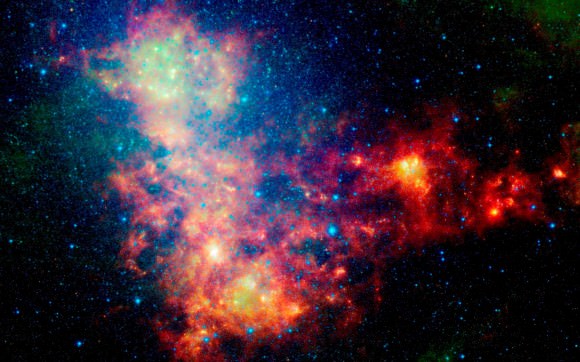Galactic Gong – Milky Way Struck and Still Ringing After 100 Million Years
Updated: 2012-06-29 16:44:30
 When galaxies collide, stars are thrown from orbits, spiral arms are stretched and twisted, and now scientists say galaxies ring like a bell long after the cosmic crash. A team of astronomers from the United States and Canada say they have heard echoes of that ringing, possible evidence of a galactic encounter 100 million years [...]
When galaxies collide, stars are thrown from orbits, spiral arms are stretched and twisted, and now scientists say galaxies ring like a bell long after the cosmic crash. A team of astronomers from the United States and Canada say they have heard echoes of that ringing, possible evidence of a galactic encounter 100 million years [...]
 If the Higgs exists, why has discovering it taken so long – and why, if no definitive discovery is announced next week, might it continue to take even longer?
If the Higgs exists, why has discovering it taken so long – and why, if no definitive discovery is announced next week, might it continue to take even longer? Our galaxy, the Milky Way, is a large spiral galaxy surrounded by dozens of smaller satellite galaxies. Scientists have long theorized that occasionally these satellites will pass through the disk of the Milky Way, perturbing both the satellite and the disk. A team of astronomers from Canada and the United States have discovered what may well be the smoking gun of such an encounter, one that occurred close to our position in the galaxy and relatively recently, at least in the cosmological sense.
Our galaxy, the Milky Way, is a large spiral galaxy surrounded by dozens of smaller satellite galaxies. Scientists have long theorized that occasionally these satellites will pass through the disk of the Milky Way, perturbing both the satellite and the disk. A team of astronomers from Canada and the United States have discovered what may well be the smoking gun of such an encounter, one that occurred close to our position in the galaxy and relatively recently, at least in the cosmological sense. A new crack in the Standard Model may be starting to form. Recently analyzed data from the BaBar experiment show that one type of particle decay happens more often than predicted by the Standard Model.
A new crack in the Standard Model may be starting to form. Recently analyzed data from the BaBar experiment show that one type of particle decay happens more often than predicted by the Standard Model.  It’s a mystery where ultra-high-energy cosmic rays come from and what they’re made of. But a new technique, currently in the works, could drastically improve scientists’ chances of finding out.
It’s a mystery where ultra-high-energy cosmic rays come from and what they’re made of. But a new technique, currently in the works, could drastically improve scientists’ chances of finding out. : SciLogs All Blogs Next Dark Matter gone missing in many places : a crisis of modern physics from Marcel S . Pawlowski 19. April 2012, 21:41 On The Dark Matter Crisis , we have already presented numerous problems that appear within the LCDM model of cosmology . Some of these have been given names , like the Missing Satellites Problem where LCDM predicts more dark matter subhaloes around the Milky Way than there are observed satellite galaxies , which are expected to trace them . Or the Missing Baryons Problem from cosmological predictions we expect a certain density in the baryonic , luminous and thus in principle observable matter . But when you add up all the visible matter you observed , you only get 10-40 per cent of what you expect . The larger fraction is missing . Even the ongoing
: SciLogs All Blogs Next Dark Matter gone missing in many places : a crisis of modern physics from Marcel S . Pawlowski 19. April 2012, 21:41 On The Dark Matter Crisis , we have already presented numerous problems that appear within the LCDM model of cosmology . Some of these have been given names , like the Missing Satellites Problem where LCDM predicts more dark matter subhaloes around the Milky Way than there are observed satellite galaxies , which are expected to trace them . Or the Missing Baryons Problem from cosmological predictions we expect a certain density in the baryonic , luminous and thus in principle observable matter . But when you add up all the visible matter you observed , you only get 10-40 per cent of what you expect . The larger fraction is missing . Even the ongoing